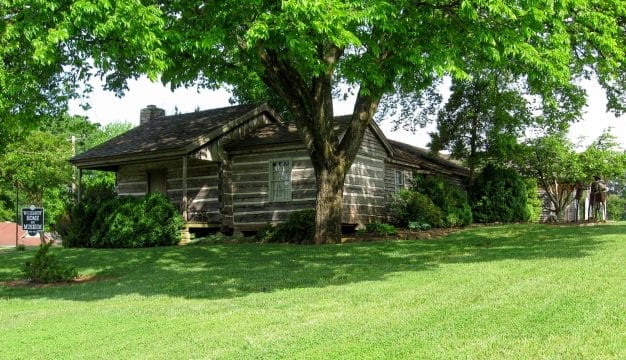Fort Sinquefield
Fort Sinquefield, named in honor of the settler whose home it stood near, was one of several hastily built stockades constructed in present-day southwest Alabama in the summer of 1813 at the outbreak of the Creek War. Located in central Clarke County, the fort enclosed about an acre of land and featured a single blockhouse. As many as 15 families took shelter there as fears of attack by the “Red Stick” faction of the Creek Nation mounted throughout the region. Sinquefield is remembered in Alabama history for an attack on September 2, 1813, by Red Stick forces led by Josiah Francis (also known as Hillis Hadjo).
 Fort Sinquefield Monument
The Battle of Fort Sinquefield is closely associated with the Kimbell-James Massacre, which occurred at the nearby plantation of Ranson Kimbell (sometimes spelled Kimball) the day prior. As many as 20 members of the Kimbell and Abner James families, who had endured uncomfortable conditions at the fort for weeks, had chosen to relocate to the Kimbell property in late August after the immediate threat of a Creek attack appeared to have passed. Shortly after three o’clock in the afternoon on September 1, 1813, however, a group of Red Stick warriors fell upon the unsuspecting families. In a matter of minutes, a dozen men, women, and children lay murdered in the home and surrounding yard. About five other men and boys had not been at the home at the time of the attack; four managed to make it to Fort Sinquefield. Abner James’s daughter Sarah Merrill and her infant son, both severely wounded and left for dead, were the sole survivors at the scene. Merrill managed to make her way to Fort Sinquefield that night only by hiding her badly wounded child in a hollow log so that she could conserve enough strength for the journey. As soon as word of what had happened reached nearby Fort Madison, commander Col. Joseph Carson sent a detachment of troops to the Kimbell home to retrieve the bodies and take them to Fort Sinquefield for burial. Sarah Merrill’s infant was recovered and would survive the attack.
Fort Sinquefield Monument
The Battle of Fort Sinquefield is closely associated with the Kimbell-James Massacre, which occurred at the nearby plantation of Ranson Kimbell (sometimes spelled Kimball) the day prior. As many as 20 members of the Kimbell and Abner James families, who had endured uncomfortable conditions at the fort for weeks, had chosen to relocate to the Kimbell property in late August after the immediate threat of a Creek attack appeared to have passed. Shortly after three o’clock in the afternoon on September 1, 1813, however, a group of Red Stick warriors fell upon the unsuspecting families. In a matter of minutes, a dozen men, women, and children lay murdered in the home and surrounding yard. About five other men and boys had not been at the home at the time of the attack; four managed to make it to Fort Sinquefield. Abner James’s daughter Sarah Merrill and her infant son, both severely wounded and left for dead, were the sole survivors at the scene. Merrill managed to make her way to Fort Sinquefield that night only by hiding her badly wounded child in a hollow log so that she could conserve enough strength for the journey. As soon as word of what had happened reached nearby Fort Madison, commander Col. Joseph Carson sent a detachment of troops to the Kimbell home to retrieve the bodies and take them to Fort Sinquefield for burial. Sarah Merrill’s infant was recovered and would survive the attack.
A funeral for the victims was just ending around noon on September 2 when Francis’s force of approximately 100 warriors rushed the fort. The attackers, many wearing turkey feathers in their hair and red-dyed cow’s tails and painted faces to instill terror in their enemies, were spotted barely in time for settlers outside the fort’s walls to retreat inside. Stranded between the warriors and safety, though, was a group of women who had been washing laundry at a spring located at the base of a ravine about 300 yards behind the fortification. Thinking quickly, Isaac Hayden, who was from the detachment out of Fort Madison, turned his pack of hunting dogs on the approaching warriors and caused enough confusion to allow all but one of the women to make it to the fort gate. Hayden was the last person to make it inside, just as his horse was shot from under him.
An intense firefight raged for the next two hours as the defenders of Fort Sinquefield successfully fought off a continuous and determined attack. During the battle, only one defender, Stephen Lacey, was killed, but at least five Red Sticks died and an unknown number were wounded. Unable to breech the fort’s defenses, the attackers abandoned the effort and left the area. That evening, the inhabitants of the fort fled to the larger and better garrisoned Fort Madison.
The site of Fort Sinquefield is located just off Highway 84 southeast of Grove Hill in central Clarke County. Listed on the National Register of Historic Places, it is today a historical park administered by the Clarke County Historical Society. The park contains several interpretive panels, a stone monument, a reconstruction of a portion of one of the fort’s walls, and a walking trail leading to the spring that figured prominently in the battle.
Additional Resources
Bunn, Mike, and Clay Williams. Battle for the Southern Frontier: The Creek War and the War of 1812. Charleston: The History Press, 2008.
Halbert, Henry S., and Timothy H. Ball. The Creek War of 1813 and 1814. Chicago: Donohue and Henneberry, 1895.
Weir, Howard T., III. A Paradise of Blood: The Creek War of 1813-14. Yardley, Penn.: Westholme Publishing, 2016.



